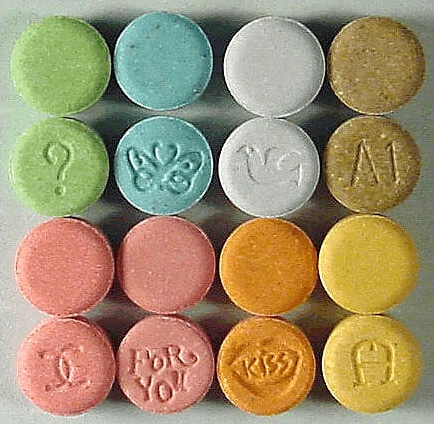SOT members were busy this week, as interviews appeared in diverse outlets, from TIME to Environmental Health Perspectives. It was also a big week for science news, as news continues to develop in the UK regarding Pfizer and AstraZenca and chemical and science funding and regulation remains a hot topic.
SOT Member Research
 Nicknamed ecstasy (pictured at right) on the street, 3,4-(±)-methylenedioxymethamphetamine (MDMA) is the subject of the May 2014 Toxicological Sciences Editor’s Highlight. The research by members Joseph M. Herndon, Aram B. Cholanians, Lucina E. Lizarraga, Serrine S. Lau, and Terrence J. Monks looks at the role catechol-O-methyltransferase (COMT) plays in the fraction of MDMA that is converted to potentially neurotoxic metabolites.
Nicknamed ecstasy (pictured at right) on the street, 3,4-(±)-methylenedioxymethamphetamine (MDMA) is the subject of the May 2014 Toxicological Sciences Editor’s Highlight. The research by members Joseph M. Herndon, Aram B. Cholanians, Lucina E. Lizarraga, Serrine S. Lau, and Terrence J. Monks looks at the role catechol-O-methyltransferase (COMT) plays in the fraction of MDMA that is converted to potentially neurotoxic metabolites.
Nancy Kerkvliet and her colleagues at Oregon State University have discovered a chemical compound that may help treat autoimmune disorders. As reported in NIEHS’ Environmental Factor, Dr. Kerkvliet and team made the discovery while studying a known toxicant called TCDD, displaying how basic toxicology research can have a wide influence.
Lisa M. Diehl explains her research on the effects of Isoproterenol HCl and Moxifloxacin HCl on cardiovascular, ECG, and blood pressure parameters in an audio podcast made available by Charles River.
SOT Members in the News
A recent TIME article delved into the topic of microbeads, examining what research has and has not discovered about their effects on the environment. Jay Ansell provides a toxicological perspective of microbeads in the piece.
In April, National Institute of Environmental Health Sciences and the Energy Future Coalition held a workshop to discuss the health impacts of ultrafine particles from vehicle emissions. SOT Past President Linda Birnbaum helped moderate the event, while Dan Costa and Andre Nel served as speakers. NIEHS’ Environmental Factor covered the workshop and discussion topics.
A new Environmental Health Perspectives feature contains quotes and research from many SOT members, including Aaron Barchowsky, Samuel Monroe Cohen, Joseph H. Graziano, and Susan Griffin. The article explores arsenic research, focusing specifically on the dose-threshold of the element.
As announced by the George Washington University School of Medicine & Health Sciences, Nikki Posnack received a $209,926 grant from the NIEHS to study plastics and their potential human health risks, particularly in the cardiovascular system. This grant will support the study of bisphenol A (BPA) and di-2-ethylhexylphthalate (DEHP), specifically.
Nancy B. Beck discusses the challenges for improving risk assessments with Robinan Gentry and Julie E. Goodman in the American Chemistry Council’s American Chemistry Matters blog.
Science Headlines
To stay abreast of these types of items throughout the week, be sure you “like” SOT on Facebook and “follow” SOT on Twitter.
Have news or research you want featured in the future? Send me an email.